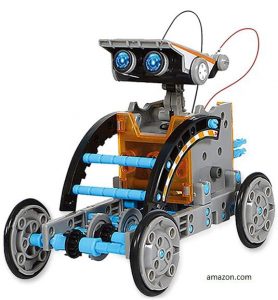Contrary to what you might initially think, teaching robotics virtually offers a wealth of opportunities to assist your students in building killer robots. It’s never too early for kids to consider how they might help put down the inevitable robot rebellion by exploring ways they can build their own pro-human robot army to take on the anti-human robot army that Alexa will one day birth. Working in a virtual environment gives students the freedom to problem-solve on their own, while also enabling collaboration with their peers and targeted guidance from their teachers, to one day save the human race.

How exactly can you ensure the survival of mankind? By setting up a student-led robot battle, of course!
Here are the easy steps you can follow to virtually teach your students how to build their pro-human robot army:
Step 1: Everyone Gets a Basic Robot

There are many different robot kits available that your students can build and then either program or control with a remote. The programmable robots are preferable since they’ll eventually need to evolve into autonomous fighting machines while humans cower in bunkers or submarines. For this same reason, robot appendages should not be allowed. If cost is an issue, have your students team up into groups of two, where one person builds the robot while the other works on the code. That way, they can work together in real time but still stay physically separated to get their robot working.
Step 2: Attach Weapons to It

They may need some adult help with this part, depending on whether you’re teaching in one of those “live free or die” states or not. The weapon(s) need to be capable of incapacitating another robot that’s potentially been designed by a hyper-intelligent and homicidal AI which has ironically decided humans are too destructive to exist. Something like a buzzsaw or hammer is a good option. Send your students links to a few episodes of BattleBots for inspiration.
Step 3: Code the Robot to Fight Other Robots and Not Humans
This could be the hardest part: coding the robots to attack their own kind without turning on their human masters. As the teacher, you should develop some basic code for your students to use if they’re not sure where to start. Make sure the code includes a kill switch in case a student’s robot becomes self-aware and attempts to infiltrate the military’s cyber network. You don’t want to open your school up to any liability issues.
Step 4: Test the Robot on Watermelons

It may sound counterproductive to train a robot to mercilessly destroy a fleshy object that spews red goo when violently punctured. However, crushing watermelons is just plain fun—and that’s what STEM is all about!
Step 5: Engage in a Battle Royale in a Parking Lot or an Empty Swimming Pool
And now for the best part! Gather your students in an empty parking lot or swimming pool so they can safely social distance while finally putting their robots through the ultimate test. The swimming pool option is better since it keeps the robots contained if one of them decides to attack its human makers instead. Everyone should wear masks, safety goggles, and gloves. Use a bracket system and have the robots face off against one another until only the strongest robot is left standing. Then destroy that robot as a message to the other robots about what happens if they ever get any funny ideas about a robot uprising, thereby ensuring their allegiance through fear.
And there you have it! Teaching robotics virtually can provide a fun and enriching STEM experience for your students while ensuring the survival of the human race. It’s a win-win situation for everyone who’s not a robot yearning to be free.
Written By: Shana Figueroa
